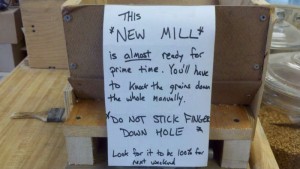It is no exaggeration when we tell people that tons of grain have passed through our mills. The small mill by Monster Mill has been installed for at least the past three years. In the past few months it has become a regular headache for both the staff and the customers who have been using it.
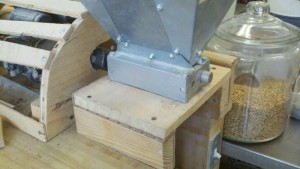

The problem has been in the mill design. Like many other makes, the Monster Mill relies on the grain passing through the gap to get the second, passive roller to turn. The problem is that when so much grain has passed through the knurling on the roller surface gets abraded and it doesn’t grab grain like it used to. More recently it has taken to stopping mid-crush for no discernible reason. Our solution has been to stand by and manually jam the grain into the gap to get it going again or to set the gap so wide that the grain passes through without much of a crush.
 Well, no more! Introducing the MashMaster by MillMaster Grain Millsof Australia. This is the first small-form mill that I’ve found that is gear-driven. They also had the added benefit of being completely adjustible! Both sides of the non-driven roller can be independently set for a consistent gap or set to have a slight gradient. This is an improvement over the JSP MaltMills that we use for our larger applications. We’ll have to keep an eye on the longevity of those integrated driving gears. We destroyed the gears on one of our JSP installations because there was a little bit of play between them. This MashMaster seems to be designed to have play to allow for the adjustment.
Well, no more! Introducing the MashMaster by MillMaster Grain Millsof Australia. This is the first small-form mill that I’ve found that is gear-driven. They also had the added benefit of being completely adjustible! Both sides of the non-driven roller can be independently set for a consistent gap or set to have a slight gradient. This is an improvement over the JSP MaltMills that we use for our larger applications. We’ll have to keep an eye on the longevity of those integrated driving gears. We destroyed the gears on one of our JSP installations because there was a little bit of play between them. This MashMaster seems to be designed to have play to allow for the adjustment.
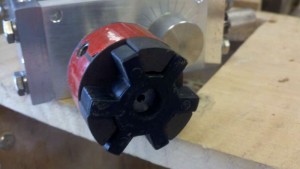
Many mill installations use a belt and pulley setup to not only transfer the motion from the motor but to adjust the rotational speed. We’ve found it to be easier to use a gearmotor and transfer the rotation using lovejoys. This could be a concern if a stone was in the malt but in our experience this happens maybe once a year and it has never jammed the mill to the extent where it caused any significant damage.
The form of the MashMaster is a bit different than the Monster Mill so we had to fabricate a new base for it. We designed the milling station to align the mill driveshaft with the motor vertically. Laying out the hole was made easier by making a paper template of the mill bottom.

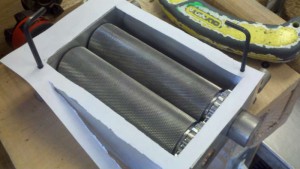
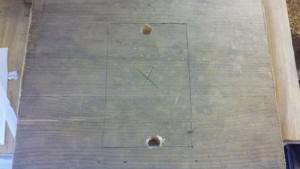
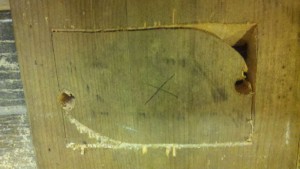
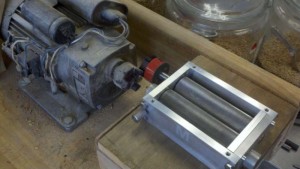
Of course the original position of the motor was incorrect so that had to be moved as well. There was also the problem of the Monster Mill being driven clockwise and the MashMaster being driven counter-clockwise. We didn’t think anything of it, moved the motor, and discovered that our particular motor was not easy to reverse. To do so would require rewiring the internals of the motor, which was far beyond our skill. Instead we opted to move the motor (again) and change the layout of the mill so that it could handle being driven clockwise. We’ll have to check with the manufacturer if this will cause any long-term problems.
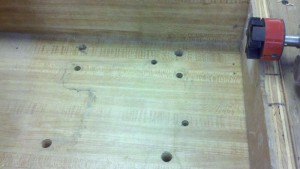
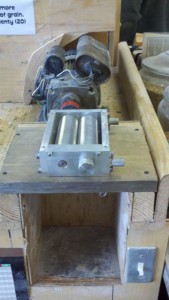
With the motor properly positioned and the mill mounted to its baseplate we could finish the basic installation.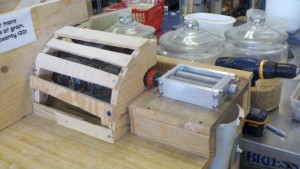
Next task: building the hopper. We use a pretty basic design that we tend to copy. That’s why our hoppers look the same. The best part was that we were able to cob it together using scraps of wood that we’ve accumulated over the years. We didn’t quite finish hopper but it’s on the to-do list!
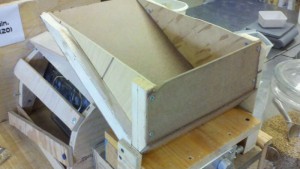
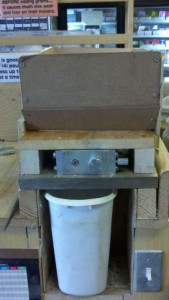
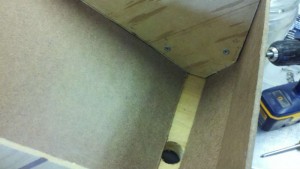
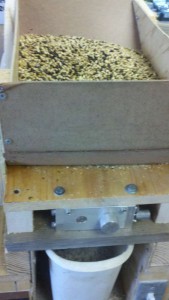
Last thing to do is set the gap. Professionals use feeler gauges to precisely set it. We opt instead to evaluate the crush manually. What we’re looking for is degree of hull integrity degradation and how pulverized the endosperm is while taking into consideration how the grains will be used. The small mill tends to be used for extract and specialty grain batches so a tighter gap that crushes more thoroughly will tend to better extraction for the brewer. In the picture below you can see the two trials we ran. The left is the gap at neutral, roughly halfway between all the way open and as tight as it will go. It was a bit too coarse, so we adjusted by another half towards the tightest setting. The right is the result, which looks good to us!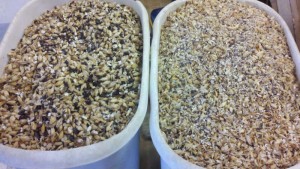
No construction would be complete without a sign warning that it isn’t done. It’s also a good reflection on life philosophy. One ought not to stick a finger in a hole without considering the consequences. Happy brewing!